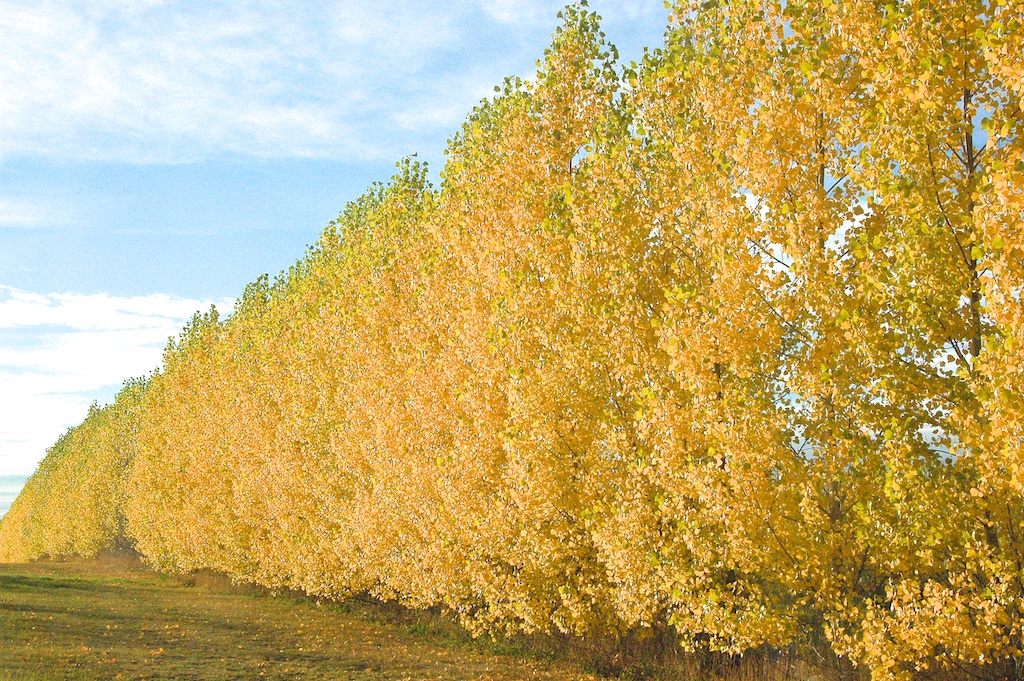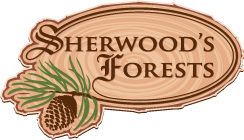
The edge were tree meets field creates a haven for all sorts of critters.
Leaf Trees
Trees that shed in the fall
All of the leaf trees we have are deciduous: They lose their leaves in the fall. Leaf trees show variety through the year, from bud break during the spring, possibly blossoms and fruit, fall colour, and maybe winter interest. Here's a quick overview:
Birches
Birches are short lived, fast growing trees. Their bark is papery.
All birch are water lovers. Every large old birch I've seen has either
been near a spring, creek bed, or septic field. I suspect that the reputation
they have for short lives comes from outgrowing their water supply.
Water it hard, water it often, and it will keep growing.
Cherries and Plums
Small trees or shrubs. Some are grown for their fruit. Most are grown for their spring blossoms. This group also includes, almonds, peaches, nectarines, and apricots, most of which don't grow here.
This whole group is pretty in spring, with blossoms that come out either before the leaves, or just as the leaves are opening. The effect is striking.
Dogwoods
There are many dogwoods. There are tree dogwoods, but all of the
ones I know are multi-stemmed shrubs or herbaceous perennials.
Dogwoods have purple-red fall foliage, a white berry that is
of interest to birds, and bark that comes in a range of colours
from dark purple to red to yellow, depending on species.
Will grow in full sun to half shade. Prefers medium to damp soils with at least some loam.
Lilacs
Drive through the countryside, and look for the gray abandoned farmsteads. Often nearby, you will see clumps of lilacs, some planted over a century ago. Some lilacs sucker profusely. Others are a bit less assertive. The common and late lilacs will be as tall as your house if you let them. Some have been selected to remain petite. All of them bloom, and are beautiful in spring. One of my customers wanted one just for the scent. She grew up with lilacs around her house, so the scent reminded her of early summer days of childhood.
Miscellaneous
You'd think that I'd have this section at the end. Someday it will migrate there, but right now my automatic webpage system puts the pages in alphabetical order. I figure that getting something up is more important that making it all 'just so'.
Anyway, this is the collection point for stuff I only carry one kind of, or that is in too small a quantity to warrant making it's own page. So browse through this section and see what piques your interest.
Ninebarks
Ninebarks invented the 'Layered Look' in fashion.
Ninebarks get their name from the several year old bark. It comes
off in shreds, and gives the appearance of multiple layers overlapping
each other. In spring it has clusters of tiny white flowers.
As a shrub it will get 4-6 feet tall, with graceful arching
branches. Foliage can range from a golden chartreuse to purple black.
Poplars
You want shade? You want it now? You want poplar.
Poplar come in a large variety of sizes. All are fast growing. All love water. Most are propagated by cuttings, so getting a fairly uniform appearance isn't difficult. Female clones produce large amounts of 'cotton' in spring. Male clones produce huge quantities of pollen.
Still, if you have a bare lot and want shade, you will get shade in 5 years with poplar.
Potentilla
Sometimes called shrubby cinqfoil, the potentillas are a staple of the landscape. They bloom from early summer to frost, are tolerant to abuse, and thrive on neglect. The native potentilla grows in dry rocky areas and has a smaller flower than the named cultivars, of which there are hundreds.
I've chosen four cultivars, one each of yellow, white, pink, and orange.
Willows
Willows come in sizes ranging from a creeper that is no taller than the rocks in your rock garden to trees that will overshadow your garage. Most, however are shrubs, or small trees. Many like water, and are tolerant of really soggy soil. None are really drought tolerant, although some will do well in well drained sandy soils.
Some willows are grown for the male blossoms (french and native pussy willow) some for their stem color as a landscape plant for for basket weaving, some for their ability to be trained in shapes, or living structures.
Willows are almost instant hedge. Plant two feet apart, water well, fertilize a bit, and you will have a hard time seeing over them in 3 years. ...
Got something to say? Email me: sfinfo@sherwoods-forests.com
Interesting? Share this page.
Want to talk right now? Call me: (8 am to 8 pm only, please) 1-780-848-2548
Do not arrive unannounced. Phone for an appointment. Why? See Contact & Hours That same page gives our hours of operation.
Back to Top
Copyright © 2008 - 2021 S. G. Botsford
Sherwood's Forests is located about 75 km southwest of Edmonton, Alberta. Please refer to the map on our Contact page for directions.
